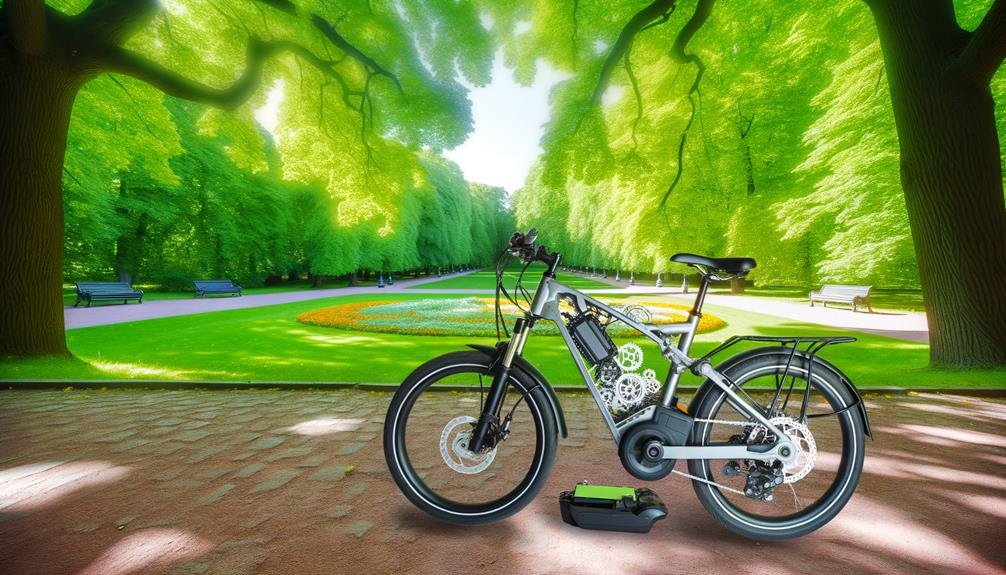Charles Miller is a veteran bike enthusiast with over 12 years of experience dealing with bikes as a mechanic. Despite immense love and expertise for...
Many individuals are increasingly considering the electric bike as an alternative mode of transportation or as a new method of exercise, sparking a discussion about the actual level of physical exertion associated with this modern innovation.
The electric bike, or e-bike, with its built-in motor to assist with pedaling, presents an interesting dichotomy: does it offer a comparable workout to traditional cycling or does its electric assist feature diminish the fitness benefits?
Although the answer may seem straightforward, multiple factors, including the level of pedal assist used and the intensity of the ride, make this a more complex question.
To fully comprehend the health potential of e-bikes, it is critical to consider these variables and to explore the emerging research in this field.
Key Takeaways
- Electric bikes provide more physical activity than traditional bikes.
- E-bike riders engage in longer-distance trips and cover greater distances.
- E-biking enhances overall physical activity levels and cardiovascular health.
- E-bikes accommodate riders of various fitness levels and abilities.
Understanding Electric Bikes
A vast majority of people remain unaware of the fact that electric bikes, also known as e-bikes, actually promote more physical activity than traditional bikes, offering the potential to cover greater distances and conquer challenging terrains more readily. This is a critical aspect in understanding electric bikes.
Predominantly, electric bikes, particularly Class 1 e-bikes, are instrumental in promoting physical activity. They provide pedal assistance up to 20 mph, enabling riders to maintain a consistent speed with less effort. This makes them suitable for a broad spectrum of fitness levels.
E-bikes differ significantly from traditional bikes in their functionality. The pedal assistance feature allows riders to tackle challenging terrains and travel longer distances than they might with a traditional bike. This encourages longer, more frequent rides and increases exercise levels, thus highlighting the advantage of electric bikes.
When choosing an e-bike, it is recommended that riders opt for a Class 1 model. Brands such as Story Bicycles offer models that strike an optimal balance between assistance and physical effort. While individual experiences with electric bikes may vary, they generally provide more exercise compared to regular bikes, underscoring the importance of understanding electric bikes for prospective riders.
Electric Bikes Vs Traditional Bikes
In the realm of exercise and physical activity, the e-bike and traditional bike rivalry presents an intriguing study of contrasts, with the former offering distinct advantages in terms of distance coverage, terrain adaptability, and fitness level inclusivity.
When evaluating electric bikes vs traditional bikes, consider the following:
- E-bike riders often surpass regular bikes in terms of exercise, covering longer distances and difficult terrain. This is enabled by the pedal assistance feature, which maintains a steady speed with less exertion.
- Particularly, Class 1 e-bikes, with pedal assistance up to 20 mph, are highly effective in encouraging physical activity.
- When selecting an e-bike model for exercise benefits, a Class 1 e-bike strikes the perfect balance between assistance and physical effort.
E-bikes inspire individuals to ride longer, further, and pedal harder, resulting in enhanced exercise. This inclusive fitness tool can accommodate riders of various fitness levels and abilities, creating a sense of belonging and unity in the biking community.
Exercise Factor: E-Bikes

When considering the exercise potential of e-bikes, two pivotal factors come into play: their calorie-burning potential and the associated health benefits.
E-bikes, with their unique blend of user effort and electronic assistance, offer distinct advantages in terms of physical activity and wellness.
This discussion will analyze the degree to which e-bikes facilitate exercise and contribute to overall health.
E-Bikes' Calorie Burning Potential
Despite common misconceptions, e-bike riders often engage in longer-distance trips than traditional cyclists, thereby increasing their overall exercise and calorie-burning potential. The e-bikes' calorie burning potential is inherently tied to the rider's commitment to a healthier lifestyle. Here are some factors that can amplify the exercise you get with an electric bike:
- Personal determination and self-discipline
- Choosing to pedal harder
- Opting for longer rides
- Bike adjustments
- Employing less motor assistance
- Adjusting to higher resistance settings
- Selecting Class 1 e-bikes
- Offers pedal assistance up to 20 mph
- Promotes physical activity
E-bikes offer a unique combination of convenience and exercise potential, making them an appealing option for both fitness and transport.
Health Benefits of E-Biking
Regularly engaging in e-biking presents a multitude of health benefits, primarily due to the increased physical activity facilitated by the pedal assistance feature. This unique aspect of electric bikes allows riders to cover longer distances and tackle more challenging terrain, consequently enhancing their overall physical activity levels.
Moreover, the health benefits of e-biking extend to a wider demographic, as this form of exercise is accessible to individuals with varying fitness levels. Specifically, Class 1 e-bikes, which provide pedal assistance up to 20 mph, are highly effective in promoting physical exertion and cardiovascular health.
When choosing an e-bike for exercise, opting for a Class 1 model is recommended, as it strikes the optimal balance between assistance and physical effort.
Health Benefits of E-Bikes
E-bikes, particularly Class 1 models that provide pedal assistance up to 20 mph, offer significant health benefits by promoting longer and more challenging rides, thus increasing overall physical activity. E-bike riders typically engage in longer-distance trips compared to traditional cyclists, which inherently contributes to increased physical activity. The health benefits of e-bikes are numerous and well-documented.
- Promotion of Overall Physical Activity: E-bikes encourage riders to travel longer distances and tackle more challenging terrain, resulting in:
- *Increased Exercise*: E-bikes can motivate individuals to ride longer, pedal harder, and thereby achieve more exercise.
- *Improved Fitness*: E-bikes can help increase breathing and heart rates, making commuting more beneficial for fitness.
The sense of belonging that comes with e-bike usage should not be underestimated. Joining a community of e-bike enthusiasts can foster a sense of camaraderie, while the health benefits of e-bikes can contribute to personal wellbeing and longevity.
Calories Burned on E-Bikes

Building on the physical activities and fitness benefits derived from e-bikes, it is essential to analyze the calories burned during these rides, a critical factor contributing to overall health improvement. A common misconception is that e-bikes offer less exercise than traditional bikes, but this is far from the truth.
The amount of calories burned on e-bikes can be significant, particularly as the convenience of these bikes encourages riders to use them more frequently and cover more miles. The level of exercise, therefore, increases. In fact, some individuals find that e-bikes provide much exercise, even more than regular bikes, despite the reduced effort.
Considering the various factors that influence the amount of exercise obtained from e-bikes, it's clear that personal experiences and bike choices play a major role. For instance, the bike's weight, the rider's enjoyment, and the speed can all affect the calories burned.
Increasing Exercise With E-Bikes
Increasing exercise with e-bikes can be approached from different angles. One angle is cardiovascular health. Electric bikes can provide a significant cardiovascular workout, improving heart health. This is especially true when using the pedal assist feature, which allows riders to increase the intensity of their workout.
Another angle is the subtle workout provided by pedal assist. While e-bikes make cycling easier, they still require some effort from the rider. The pedal assist feature provides a low-impact form of exercise, making it accessible to a wide range of individuals, including those with joint issues or limited mobility.
Additionally, e-biking offers mental benefits. Frequent e-biking can contribute to stress reduction and improved mood. Engaging in physical activity outdoors and enjoying the scenery can have a positive impact on mental well-being.
E-Bikes and Cardiovascular Health
Often overlooked, the role of electric bikes in promoting cardiovascular health through increased exercise is both significant and multifaceted. Riding an e-bike not only boosts your heart rate but also allows you to engage in longer-distance trips, effectively improving your cardiovascular health.
The link between e-bikes and cardiovascular health:
- Class 1 e-bikes, with pedal assistance up to 20 mph, promote physical activity, driving a healthy heart rate.
- E-bikes encourage individuals to ride longer and pedal harder, increasing heart rate and enhancing cardiovascular health.
- Personal preferences and bike choices can shape the level of exercise obtained from electric bikes, enabling a sense of belonging within the e-bike community.
Harness the power of e-bikes to step up your cardio game and experience better health.
Pedal Assist: Subtle Workout
While the cardiovascular benefits of e-bikes are noteworthy, it's equally important to explore how the pedal assist feature of these vehicles can subtly yet effectively augment physical exercise.
The pedal assistance mechanism in class 1 e-bikes promotes a subtle workout, enabling riders to maintain a consistent speed with less effort than traditional bikes. This encourages longer, harder rides, thereby increasing exercise levels.
Using bike computers or apps to track progress can further motivate riders. The choice of e-bike model, as well as personal experiences, significantly influence the level of exercise.
Thus, for those seeking a balance between assistance and physical effort, class 1 e-bikes come highly recommended. This approach ensures that e-bike users are part of a community that values health, balance and progress.
Mental Benefits of E-Biking
Surprisingly, the mental benefits of e-biking, particularly in terms of increased exercise, are extensive and potentially transformative for many individuals. The combination of physical movement and outdoor exposure can significantly boost mood and reduce stress levels.
- *E-biking and Mental Health*: The mental benefits of e-biking are substantial. Regular biking can:
- Improve Mood: By releasing endorphins, the body's natural feel-good chemicals.
- Reduce Stress: Physical activity like biking reduces the body's stress hormones.
- Boost Confidence: Achieving cycling goals can enhance self-esteem.
These health benefits build a sense of belonging among e-bikers, fostering a supportive community. E-biking is not just about physical fitness; it's an all-encompassing approach to wellness that includes significant mental health benefits.
Case Study: E-Bike Users' Fitness Levels
The case study unveils that electric bike riders, particularly those using Class 1 e-bikes, engage in longer-distance trips compared to traditional cyclists, thereby experiencing increased levels of physical activity. A new study demonstrated that e-bike riders cover more miles, taking advantage of the pedal-assist feature, leading to heightened fitness levels.
The table below provides a succinct summary:
| Traditional Cycling | Class 1 E-biking | |
|---|---|---|
| Average trip distance | Shorter | Longer |
| Physical activity | High | Similar or Higher |
| Enjoyment level | Variable | Higher |
Personalized adjustments can further enhance the exercise potential of e-bike commuting. The study found riders often pedal harder than necessary, transforming their commute into a workout. This debunks the myth of less exercise with e-bikes. Indeed, e-bikes make riding more enjoyable, encouraging people to ride more frequently and thereby increasing overall exercise levels.
This case study underlines that e-biking can be integrated into a fitness routine effectively. By belonging to the e-bike community, you're not only embracing a sustainable mode of transport, but also a healthier lifestyle.
Frequently Asked Questions
Do You Still Get Good Exercise on an Electric Bike?
Yes, you indeed get substantial exercise on an electric bike. The combination of E-bike resistance training and adjustable pedal-assist intensity allows riders to engage in moderate to vigorous physical activity, tailored to individual fitness levels.
How Much Exercise Do You Really Get on an E-Bike?
An e-bike offers substantial health benefits by facilitating longer, more challenging rides. The exercise intensity compares favorably with traditional cycling, often resulting in higher workout levels due to increased frequency and duration of rides.
Does Riding an Electric Bike Help You Lose Weight?
Riding an electric bike can indeed aid in weight loss. The efficiency of eBikes can result in significant calorie burn rates, promoting a healthier lifestyle and contributing to weight reduction when combined with a balanced diet.
What Are the Disadvantages of Ebikes?
E-bikes present several disadvantages such as higher maintenance challenges, potentially higher costs, and a larger environmental impact due to battery disposal. Additionally, their heavier weight and limited range may restrict usability and maneuverability.
Conclusion
In conclusion, it can be surmised that electric bikes provide a significant amount of exercise. The level of physical activity depends on various factors such as pedal assist and personal effort.
E-bikes not only promote increased frequency of rides but also burn calories, and offer considerable health benefits.
Thus, incorporating E-bikes into daily routines could potentially enhance fitness levels and contribute to a healthier lifestyle, making them a worthy addition to the cycling world.

Charles Miller is a veteran bike enthusiast with over 12 years of experience dealing with bikes as a mechanic. Despite immense love and expertise for his Tacoma, he rides his Trek Ebike more. Anytime you meet him, you’ll either hear him talking about Bikes, or writing about all things bikes and cars on this blog.
More Posts


